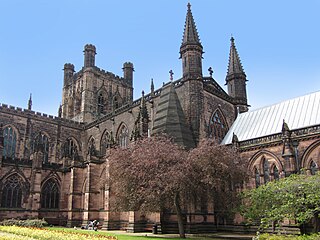
Chester Cathedral is a Church of England cathedral and the mother church of the Diocese of Chester. It is located in the city of Chester, Cheshire, England. The cathedral, formerly the abbey church of a Benedictine monastery dedicated to Saint Werburgh, is dedicated to Christ and the Blessed Virgin Mary. Since 1541, it has been the seat of the Bishop of Chester.
York had around 45 parish churches in 1300. Twenty survive, in whole or in part, a number surpassed in England only by Norwich, and 12 are used for worship. This article consists of a list of medieval churches which still exist in whole or in part, and a list of medieval churches which are known to have existed in the past but have been completely demolished.

St Nicholas Church in Thames Ditton, Surrey, England, is a Grade I listed Anglican parish church that has parts that date back to the 12th century.

St Michael's Church is a Church of England parish church in St Albans, Hertfordshire, England. Much of the building is late 10th or early 11th century, making it the most significant surviving Anglo-Saxon building in the county. It is located near the centre of the site of Roman Verulamium to the west of the modern city.

St Mary's Church is an Anglican parish church in the village of Newbold Astbury, Cheshire, England. It is recorded in the National Heritage List for England as a designated Grade I listed building, and its architecture has been praised by a number of writers.

St Mary's Creative Space, formerly the Church of St Mary-on-the-Hill, stands at the top of St Mary's Hill, Chester, Cheshire, England, near Chester Castle. It is recorded in the National Heritage List for England as a designated Grade I listed building. The church stands at the top of a narrow winding lane which leads down to the River Dee, and it is adjacent to Chester Castle. In the 1970s the church was converted into an educational centre. It is currently available for use as a concert and exhibition venue and the Chester Music Society hold many concerts there throughout the year. The venue is programmed by Theatre in the Quarter, and hosts a variety of art and cultural events, from homegrown Cestrian performers, national and international acts.

St Helen Witton Church, Northwich, is in the centre of the town of Northwich, Cheshire, England. It is recorded in the National Heritage List for England as a designated Grade I listed building. The church is now known as "St Helen's, Witton" or "Northwich Parish Church". It is an active Anglican parish church in the diocese of Chester, the archdeaconry of Chester and the deanery of Middlewich. Alec Clifton-Taylor includes it in his list of 'best' English parish churches.

St John the Baptist's Church is the former cathedral of Chester, Cheshire, England during the Early Middle Ages. The church, which was first founded in the late 7th Century by the Anglo Saxons, is outside Chester's city walls on a cliff above the north bank of the River Dee. It is now considered to be the best example of 11th–12th century church architecture in Cheshire, and was once the seat of the Bishop of Lichfield from 1075 to 1095.

St Bertoline's Church is in the village of Barthomley, Cheshire, England. The church is recorded in the National Heritage List for England as a designated Grade I listed building. It is an active Anglican parish church in the diocese of Chester, the archdeaconry of Macclesfield and the deanery of Congleton.

St Bene't's Church is a Church of England parish church in central Cambridge, England. Parts of the church, most notably the tower, are Anglo-Saxon, and it is the oldest church in Cambridgeshire as well as the oldest building in Cambridge.
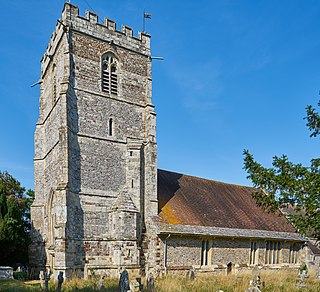
Cranborne Priory is a former priory church in the village of Cranborne, Dorset, England. Founded in 980 as Cranborne Abbey, it became a priory in 1102, remaining that way until it was dissolved in 1540. The tower, nave and aisles from the priory survive to form the Church of St Mary and St Bartholomew, the parish church of Cranborne. The building, which has fragments from the 12th century, is designated a Grade I listed building.

St Peter's Church is a redundant Anglican church in the village of Offord D'Arcy, Cambridgeshire, England. It is recorded in the National Heritage List for England as a designated Grade I listed building, and is under the care of the Churches Conservation Trust. The church stands adjacent to the East Coast Main Railway Line, overlooking the River Great Ouse.
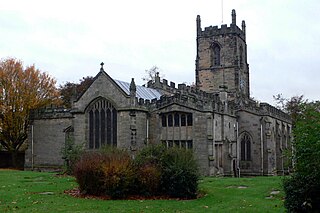
St Helen's Church is the Anglican parish church of Ashby-de-la-Zouch, in the deanery of North West Leicestershire and the Diocese of Leicester. There was a church in the town in the 11th century, but the core of the present building mainly dates from work started in 1474, when the church was rebuilt by William Hastings at the same time that he converted his neighbouring manor house into a castle. The church was refurbished in about 1670 to create more space, but the large and increasing size of the congregation led to further work in 1829, and a major rebuild in 1878–80, including the widening of the nave by the addition of two outer aisles.

All Saints, Frindsbury, is a parish church serving the combined parish of Frindsbury with Upnor and Chattenden. The church dates from 1075 and lies in the north-west corner of the Medway Towns, historically part of Kent, England. It is a Grade II* listed building, National Heritage List number 1107886.

St Mary's Church is in the town of Kirkby Lonsdale, Cumbria, England. It is an active Anglican parish church in the deanery of Kendal, the archdeaconry of Westmorland and Furness, and the diocese of Carlisle. Its benefice is united with those of six local churches to form the Kirkby Lonsdale Team Ministry. The church contains Norman architecture and is recorded in the National Heritage List for England as a designated Grade I listed building.
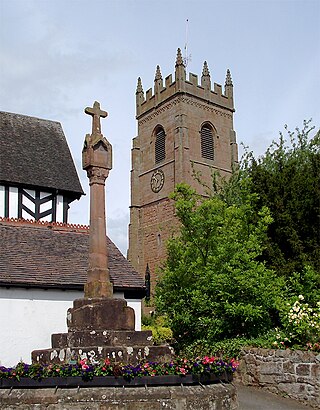
All Saints Church is in the village of Claverley, Shropshire, England. It is an active Anglican parish church in the deanery of Bridgnorth, the archdeaconry of Ludlow, and the diocese of Hereford. Its benefice is united with that of Holy Innocents, Tuck Hill. The church is recorded in the National Heritage List for England as a designated Grade I listed building.
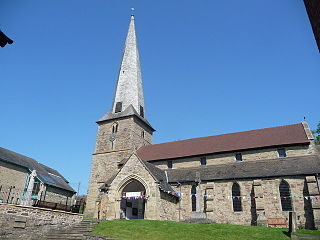
St Mary's Church is on Church Street, Cleobury Mortimer, Shropshire, England. It is an active Anglican parish church in the deanery of Ludlow, the archdeaconry of Ludlow, and the diocese of Hereford. Its benefice is united with those of six local parishes to form the Cleobury Benefice. The church is recorded in the National Heritage List for England as a designated Grade I listed building. It is notable for its shingled twisted spire.

St Piran's Church is an active Anglican parish church in Perranarworthal, Cornwall, England. It is part of a united benefice consisting of eight churches, the Eight Saints Cluster, in the parishes of Stithians with Perran-Ar-Worthal and Gwennap. The benefice has four licensed clergy and four readers. The church, dedicated to Saint Piran, is in the Carnmarth, North deanery, the archdeaconry of Cornwall and the Diocese of Truro. The church was granted Grade II* listed status in May 1967. The churchyard contains several listed chest tombs and headstones.

The Church of Saint Mary the Virgin is the Church of England parish church of Bampton, West Oxfordshire. It is in the Archdeaconry of Dorchester in the Diocese of Oxford.
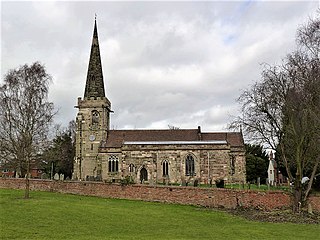
St Mary's Church is a parish church of the Church of England in Rolleston on Dove, Staffordshire. Parts of the structure date to 1130, though it was extensively renovated in 1892. It is unusual in having the main entrance door on the north side, with the southern entrance reserved for members of the Mosley family, local landowners and key donors to the church. The church features stained glass windows dating to the medieval period and others by Victorian designer Charles Eamer Kempe. The tower houses eight bells, one dating to 1586. The church is grade I listed and there are associated grade II listings for churchyard railings, a memorial, the lychgate and a former church grammar school. The lychgate, by Lincolnshire architect Cecil Greenwood Hare, also functions as a war memorial.





















